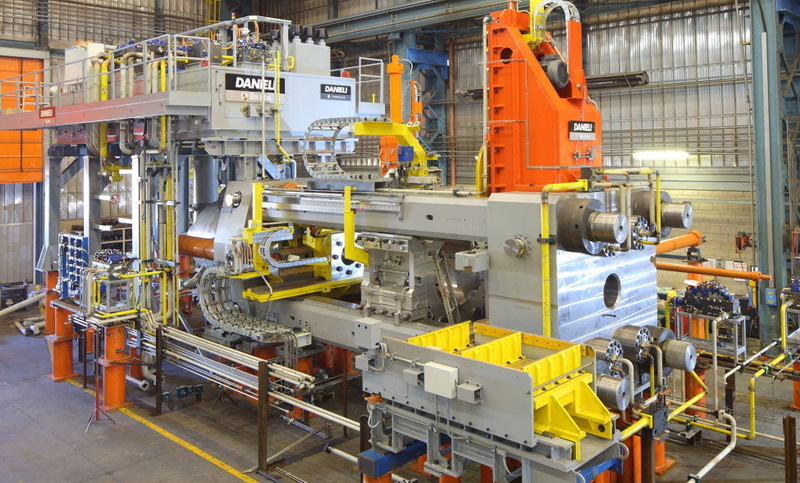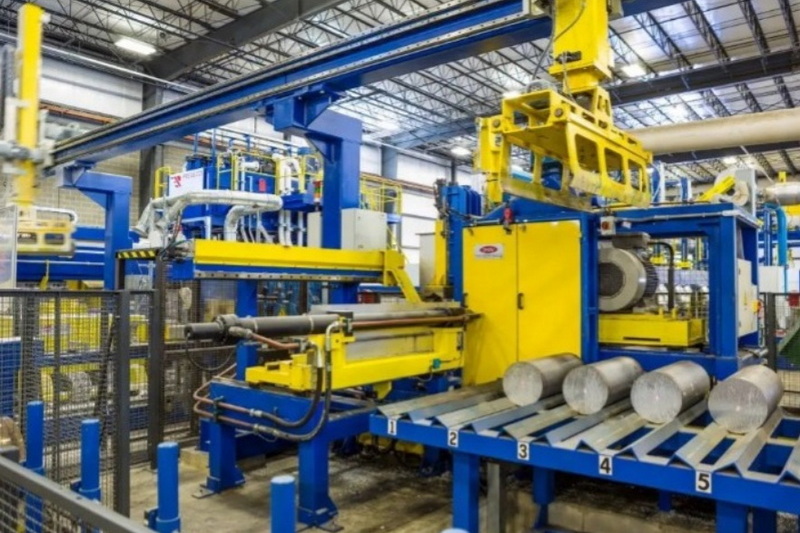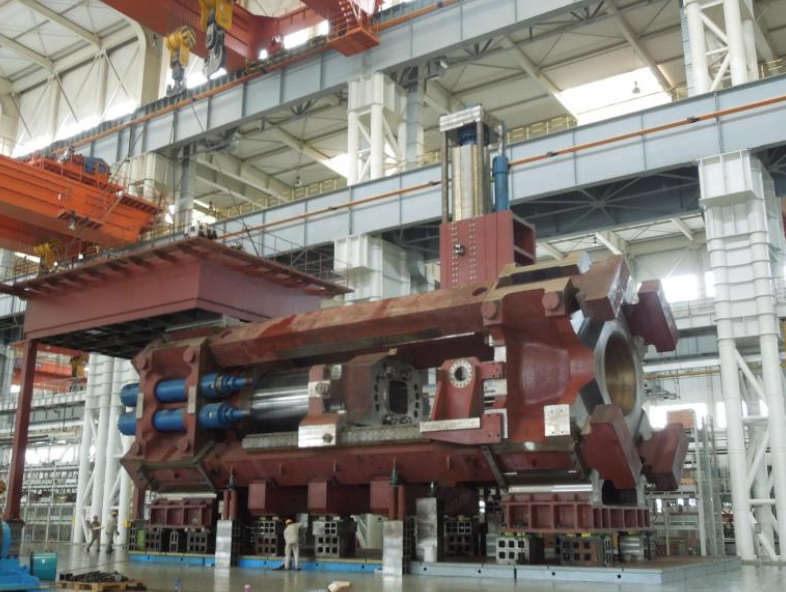Content Menu
● Understanding the Importance of the Platen
● Signs That Your Platen Needs Repair or Replacement
● Preparing for Platen Repair or Replacement
● Steps to Replace an Aluminum Extrusion Press Platen
● Repairing an Aluminum Extrusion Press Platen
● Maintenance Tips to Extend Platen Life
● The Role of Technology in Platen Maintenance
● Case Study: Successful Platen Replacement
● Environmental Considerations
● Training and Safety
● Conclusion
● FAQ
>> 1. How often should an aluminum extrusion press platen be replaced?
>> 2. Can I repair a cracked aluminum extrusion press platen?
>> 3. How does platen condition affect extrusion quality?
>> 4. What are the signs that my aluminum extrusion press platen needs replacement?
>> 5. Can improving platen maintenance extend its lifespan?
● Citations:
The front platen of an aluminum extrusion press is a critical component that directly impacts die performance. Its condition should be checked frequently using a straightedge and feeler gauge. The main concerns are looseness, cracking, or distortion, such as "coining," where a permanent impression is made in the pressure ring. If any damage is detected, the pressure ring must be repaired or replaced. In some cases, an old ring can be restored to a smooth and parallel condition through grinding and shimming.[1]
Given the importance of the platen in the extrusion process, proper maintenance, repair, and replacement procedures are crucial for ensuring optimal press performance and product quality. This comprehensive guide will walk you through the steps involved in replacing or repairing an aluminum extrusion press platen, along with essential considerations and best practices.

Understanding the Importance of the Platen
Before diving into the repair and replacement process, it's crucial to understand why the platen is so important in aluminum extrusion:
The aluminum extrusion process begins with loading a die into the press. This die has openings that will create the desired profile when aluminum is pushed through. The platen plays a critical role in supporting the die and maintaining proper alignment throughout the extrusion process.[2]
As pressure is applied, the aluminum billet is crushed against the die. The platen must withstand this immense pressure while ensuring that the aluminum flows evenly through the die openings to create the desired profile.[2]
Given its critical role, any issues with the platen can lead to:
1. Misalignment of the die
2. Uneven pressure distribution
3. Inconsistent extrusion profiles
4. Reduced product quality
5. Increased wear on other press components
Signs That Your Platen Needs Repair or Replacement
Before proceeding with repair or replacement, it's essential to identify whether your platen actually needs attention. Here are some signs to look out for:
1. Visible cracks or damage
2. Uneven wear patterns
3. Difficulty maintaining proper die alignment
4. Inconsistent extrusion quality
5. Increased frequency of die failures
6. Unusual noises or vibrations during operation
Regular inspections using a straightedge and feeler gauge can help detect issues early. Pay particular attention to signs of looseness, cracking, or distortion in the pressure ring.[1]
Preparing for Platen Repair or Replacement
Before beginning the repair or replacement process, proper preparation is crucial:
1. Safety First: Ensure all safety protocols are in place and the press is fully shut down and locked out.
2. Gather Tools and Equipment: You'll need specialized tools for removing and installing the platen. Consult your press manufacturer's manual for specific requirements.
3. Order Replacement Parts: If replacing the platen, ensure you have the correct replacement part on hand before beginning the process.
4. Clear the Work Area: Remove any obstacles and ensure you have adequate space to work around the press.
5. Document Current Setup: Take photos and measurements of the current platen setup to aid in reinstallation or alignment of the new platen.
Steps to Replace an Aluminum Extrusion Press Platen
Replacing a platen is a complex process that should only be undertaken by trained professionals. Here's a general overview of the steps involved:
1. Remove the Die and Tooling: Carefully remove the die and any associated tooling from the press.
2. Disconnect Hydraulics and Electrical: Safely disconnect any hydraulic lines and electrical connections to the platen.
3. Remove Fasteners: Carefully remove all bolts or fasteners securing the platen to the press frame.
4. Extract the Old Platen: Using appropriate lifting equipment, carefully remove the old platen from the press.
5. Inspect the Press Frame: With the old platen removed, inspect the press frame for any damage or wear that might affect the new platen's installation.
6. Install the New Platen: Carefully lower the new platen into place, ensuring proper alignment with the press frame.
7. Secure the New Platen: Reinstall all fasteners, following the manufacturer's torque specifications.
8. Reconnect Systems: Reconnect all hydraulic and electrical systems.
9. Align and Calibrate: Perform necessary alignment and calibration procedures to ensure the new platen is correctly positioned.
10. Test and Adjust: Run test extrusions and make any necessary adjustments to ensure proper operation.

Repairing an Aluminum Extrusion Press Platen
In some cases, it may be possible to repair a damaged platen rather than replacing it entirely. Here are some common repair procedures:
1. Surface Grinding: If the platen surface has minor imperfections or uneven wear, it may be possible to restore it through precision grinding.
2. Welding Repairs: Small cracks or damaged areas might be repairable through specialized welding techniques.
3. Shimming: In cases of slight misalignment, adding shims can help restore proper positioning.
4. Pressure Ring Replacement: Often, replacing just the pressure ring can resolve issues without needing to replace the entire platen.[1]
It's important to note that these repairs should only be attempted by experienced professionals with the proper equipment and expertise.
Maintenance Tips to Extend Platen Life
Prevention is always better than cure. Here are some maintenance tips to help extend the life of your aluminum extrusion press platen:
1. Regular Inspections: Conduct frequent visual inspections and use a straightedge and feeler gauge to check for any signs of wear, damage, or misalignment.
2. Proper Alignment: Ensure that the platen remains properly aligned with other press components. Even slight misalignments can lead to accelerated wear.
3. Avoid Overloading: Always operate the press within its designed capacity to prevent excessive stress on the platen.
4. Maintain Proper Lubrication: Ensure all moving parts are properly lubricated to reduce friction and wear.
5. Clean Regularly: Keep the platen and surrounding areas clean from debris and excess aluminum buildup.
6. Monitor Temperature: Avoid rapid temperature changes that could lead to thermal stress and potential cracking.[1]
The Role of Technology in Platen Maintenance
Modern technology is playing an increasingly important role in maintaining aluminum extrusion press platens:
1. Sensors and Monitoring Systems: Advanced sensors can detect minute changes in pressure, alignment, and temperature, allowing for early detection of potential issues.
2. Predictive Maintenance Software: AI-powered software can analyze data from these sensors to predict when maintenance or replacement might be necessary, helping to prevent unexpected downtime.
3. 3D Scanning and Modeling: These technologies can be used to create precise digital models of platens, aiding in the design of replacement parts or repair strategies.
4. Advanced Materials: Ongoing research into new materials and coatings may lead to more durable and longer-lasting platens in the future.
Case Study: Successful Platen Replacement
To illustrate the impact of proper platen maintenance and replacement, let's consider a case study:
A medium-sized aluminum extrusion company was experiencing increasing quality issues with their extrusions. Upon inspection, it was discovered that their main press platen had developed significant wear and minor cracking.
The company decided to invest in a full platen replacement. The process took three days to complete, including alignment and calibration. While this resulted in some downtime, the benefits were significant:
1. Extrusion quality immediately improved, reducing scrap rates by 15%.
2. Press efficiency increased by 10% due to reduced setup times and fewer adjustments needed during production runs.
3. Die life was extended by an average of 20% due to more consistent pressure distribution.
4. Energy consumption of the press decreased by 5% due to improved overall efficiency.
This case demonstrates how timely replacement of a worn platen can have far-reaching benefits for an extrusion operation.
Environmental Considerations
When replacing or repairing an aluminum extrusion press platen, it's important to consider the environmental impact:
1. Recycling: Old platens should be properly recycled to recover valuable materials.
2. Energy Efficiency: A well-maintained platen can contribute to overall press efficiency, reducing energy consumption.
3. Waste Reduction: Proper platen maintenance can reduce scrap rates, minimizing waste in the extrusion process.
4. Sustainable Materials: Consider using platens made from sustainably sourced or recycled materials when possible.
Training and Safety
Proper training is crucial for anyone involved in platen maintenance, repair, or replacement:
1. Safety Protocols: Ensure all staff are trained in proper safety procedures for working with heavy equipment.
2. Technical Training: Provide comprehensive training on platen maintenance and replacement procedures.
3. Ongoing Education: Keep staff updated on new technologies and best practices in platen maintenance.
4. Documentation: Maintain detailed records of all maintenance and replacement procedures for future reference.
Conclusion
Maintaining, repairing, or replacing an aluminum extrusion press platen is a critical aspect of ensuring the efficiency and quality of your extrusion operations. By understanding the signs of wear, following proper maintenance procedures, and knowing when to repair or replace, you can maximize the lifespan of your platen and optimize your extrusion process.
Remember that while some maintenance tasks can be performed in-house, major repairs or replacements should always be carried out by trained professionals. Investing in regular maintenance and timely replacements will pay off in improved product quality, increased efficiency, and reduced downtime.
As technology continues to advance, we can expect to see even more sophisticated methods for monitoring and maintaining platens. Staying informed about these developments can help you make the best decisions for your extrusion operations.

FAQ
1. How often should an aluminum extrusion press platen be replaced?
The frequency of platen replacement depends on various factors, including press usage, maintenance practices, and the specific materials being extruded. Generally, a well-maintained platen can last several years. However, it's crucial to conduct regular inspections and replace the platen when signs of significant wear or damage are observed, rather than adhering to a strict timeline.
2. Can I repair a cracked aluminum extrusion press platen?
Minor cracks in a platen may be repairable through specialized welding techniques. However, this should only be attempted by experienced professionals. In many cases, especially with larger cracks or extensive damage, full replacement of the platen is the safer and more reliable option.[1]
3. How does platen condition affect extrusion quality?
The condition of the aluminum extrusion press platen directly impacts extrusion quality. A worn or damaged platen can lead to uneven pressure distribution, misalignment of the die, and inconsistent extrusion profiles. This can result in increased scrap rates, reduced product quality, and potential damage to other press components.
4. What are the signs that my aluminum extrusion press platen needs replacement?
Key signs that your platen may need replacement include visible cracks or damage, uneven wear patterns, difficulty maintaining proper die alignment, inconsistent extrusion quality, increased frequency of die failures, and unusual noises or vibrations during operation. Regular inspections using a straightedge and feeler gauge can help detect these issues early.[1]
5. Can improving platen maintenance extend its lifespan?
Yes, proper maintenance can significantly extend the lifespan of an aluminum extrusion press platen. Regular inspections, proper alignment, avoiding overloading, maintaining proper lubrication, regular cleaning, and monitoring temperature can all contribute to prolonging the life of your platen. Implementing a comprehensive maintenance program can help identify and address potential issues before they lead to major damage or failure.
Citations:
[1] https://www.pressmanual.online/wp-content/uploads/2023/05/1-routine-maint-2022a.pdf
[2] https://www.youtube.com/watch?v=iiGlq7408ME
[3] https://www.extrusion.net
[4] https://www.castool.com/wp-content/uploads/2024/03/The-Maintenance-of-Extrusion-Presses.pdf
[5] https://profileprecisionextrusions.com/aluminum-extrusion-manufacturing-process/
[6] https://superiorextrusion.com
[7] https://tricityextrusion.com/roxyfileman/uploads/AEC_2018_Aluminum_Extrusion_Manual.pdf
[8] https://www.youtube.com/watch?v=P8BWQBP4Vhk
[9] https://www.alamy.com/stock-photo/aluminum-extrusion.html






















